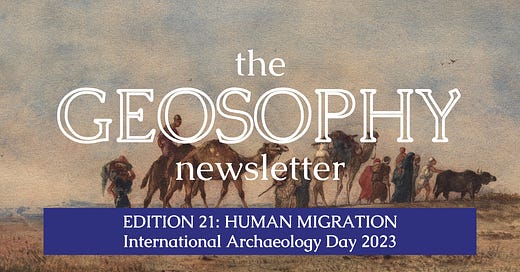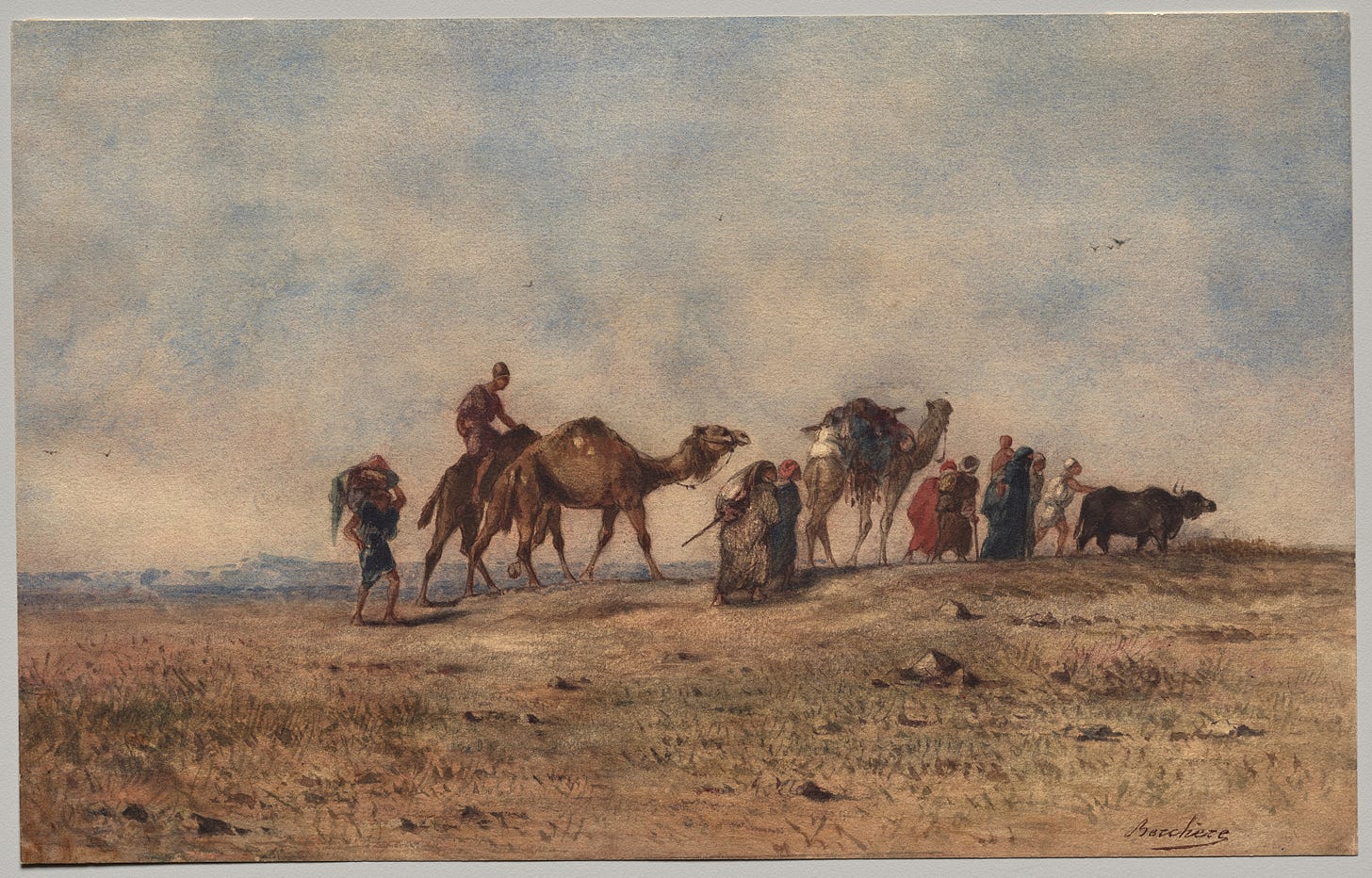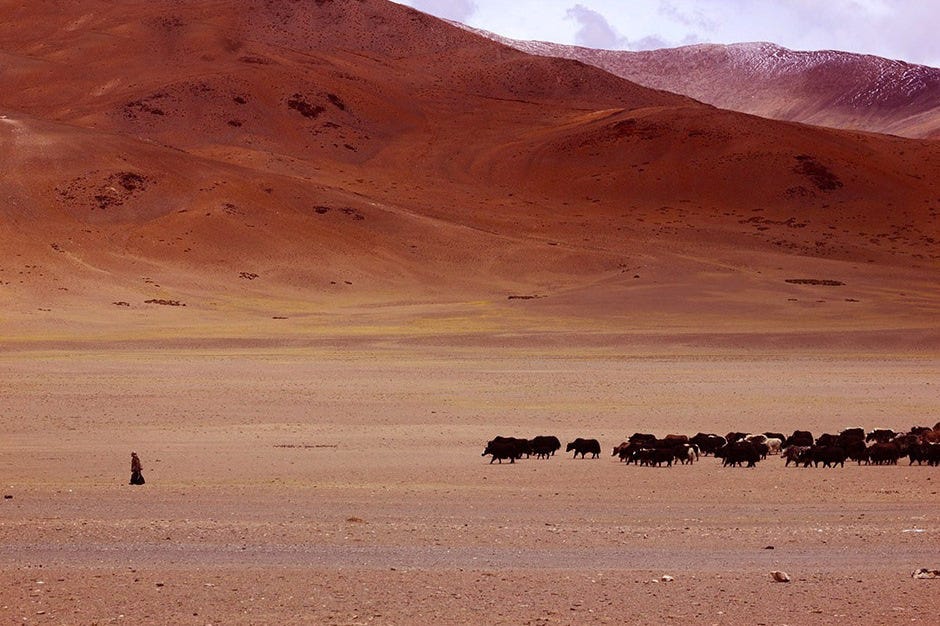"Migration powers economic growth, reduces inequalities and connects diverse societies. Yet it is also a source of political tensions and human tragedies."
― Antonio Guterres
Dear Reader,
A few weeks ago, I started research for a guest blog on 'International Archaeology Day' — I was eager to explore themes beyond the dazzle of grand discoveries like prehistoric civilisations, sunken treasures, forgotten cities and ancient temples.
As archaeology is the study of our shared human history, what better topic than migration — an integral, critical aspect of human settlement across the four corners of the globe — to highlight how our cultural, political, and socio-economic tapestries have been woven?
In this space, I want to reflect a little more on migration, especially in the context of India.
Prehistoric Migrations: India
Featured image from: Katerina Douka, Michelle O’Reilly, Michael D. Petraglia – On the origin of modern humans: Asian perspectives; Science 08 Dec 2017: Vol. 358, Issue 6368, DOI: 10.1126/science.aai9067 [1], CC BY-SA 4.0 (Wikimedia Commons) with minor edits.
As per most sources, the history of prehistoric migration to India can be divided into four significant waves:
1. The First Indians (Around 65,000 years ago): The first wave of migration brought the earliest modern humans to India, approximately 65,000 years ago. This migration was part of the broader "Out of Africa" movement that eventually populated the entire world. The genetic lineage of these initial migrants, referred to as the 'First Indians,' remains a dominant component of the Indian population, accounting for 50-65% of Indian ancestry today.
2. The Zagros Agriculturists (9000 to 5000 years ago): The second wave occurred around 9,000 to 5,000 years ago when agriculturists from the Zagros region of Iran migrated to northwestern India. They mixed with the First Indians and significantly contributed to the development of farming practices already underway in the subcontinent. This wave of migration played a crucial role in the rapid spread of farming, particularly the cultivation of barley and wheat, across the northwestern region. These developments laid the foundation for the Harappan Civilization, which thrived from 2600 BCE to 1900 BCE. The Harappans represented a blend of Zagros agriculturists and First Indians.
3. The Southeast Asian Migrations (Around 2000 BCE): The third major migration took place around 2000 BCE, originating from Southeast Asia. It began with farming-related migrations from the Chinese heartland and subsequently extended into Southeast Asia before reaching India. This wave introduced the Austroasiatic family of languages, including languages such as Mundari and Khasi, primarily spoken in eastern and central parts of India.
4. The Central Asian Pastoralists (Between 2000 and 1000 BCE): The final significant migration occurred between 2000 and 1000 BCE when central Asian pastoralists, known as Aryans, migrated to India. These migrants spoke Indo-European languages and significantly impacted the cultural and linguistic landscape of the Indian subcontinent. These four waves of prehistoric migration have played a crucial role in shaping the genetic diversity, culture, and languages of the Indian population. Each wave brought its own contributions and influences, leading to the complex tapestry of India's historical and genetic heritage.
Debunked Migration Theories
The Aryan Invasion theory, gained momentum with 19th century studies into the decline of the Indus Valley (Harappan) Civilization, which coincided with the period of the supposed Indo-Aryan migration. The archaeologist Mortimer Wheeler, misinterpreted unburied corpses found in the upper levels of Mohenjo-daro as victims of conquest and argued that the decline was a result of destructive invasion.
The Aryan Invasion theory, based on shaky linguistic, archaeological, and interpretative factors, has been discarded in favour of other models.
The "Out of India" model, also known as the Indigenous Aryan theory, suggested that the Indo-European languages, which include Sanskrit, Greek, Latin, and many others, originated within the Indian subcontinent and subsequently spread outward to other parts of the world. The theory proposed that the ancient Aryans, who are often thought of as Indo-European speakers, were indigenous to India, and their migration from India led to the diffusion of Indo-European languages to regions like Europe and beyond.
While the "Out of India" model was primarily based on linguistic and cultural arguments, it had political and nationalist implications, particularly in the context of India. The "Out of India" model was criticized for its lack of scientific support, and its potential to be misused for political and nationalist purposes, and ultimately refuted. It was seen as an attempt to assert India's cultural and historical primacy and to emphasize the indigenous nature of Indian civilization - we see disturbing strains of the same in today's political rhetoric.
While the theory outlined 'migration' as a critical pathway for the spread of languages and cultures, it oversimplified the complex and multi-faceted nature of early human migrations.
As these theories are discredited in scientific circles, I will not go into critical detail for each but merely use them as stepping stones to understand where stereotypes may emerge, and how our socio-political narratives are shaped over time.
Colonial-Era & Present-Day Migrations
India, despite numerous social, cultural, and traditional barriers, holds the distinction of being the world's largest migrant-origin country. This status is a result of its migration patterns deeply rooted in its colonial history and historical events, evolving through different periods. Colonial Rule and Indentured Servitude (19th Century): During the British colonial era, Indian labourers and indentured workers were taken to plantations and for various construction projects. These laborers were often coerced into a system known as the coolie system, which involved the movement of workers to various British colonies. The kangani system in Malaya and Ceylon and the maistry system in Burma are similar. Although workers were legally free, their conditions often resembled quasi-slavery.
Partition and the Postwar Movement: The breakup of the British Empire in 1947 marked a critical juncture in Indian migration history. The partition of India into two dominions, India and Pakistan, led to one of the world's largest forced migrations, with an estimated 20 million people displaced, primarily along religious lines. This partition resulted in massive refugee movements and widespread violence, particularly in the Punjab region, causing significant loss of life and displacement. Historians recognise the Punjab Partition as the largest migration in human history.
Labour Migration to the Middle East and the West: Another major wave of Indian emigration occurred as a result of the Gulf region's oil extraction and construction boom in the 1970s. Indian migrants, especially from Kerala, were drawn to sectors like retail, construction, healthcare, and other trades. A significant number of highly educated Indian professionals, including doctors, engineers, and financial experts, have migrated to economically developed nations, including the United States. India has the highest number of emigrants with post-secondary degrees, particularly in OECD countries.
Nomadic tribes: not all who wander are lost
The Changpa nomads herding yak in the cold desert landscape of Ladakh. Image credit: Narender9, via Wikimedia Commons
Nomadic tribes in India encompass a wide spectrum of livelihoods and traditions, exemplifying the incredible diversity within the country. Estimates for India's nomadic population range from 1.2%-7%, and these communities can be categorized into three main groups: hunter-gatherers, pastoralists, and peripatetic or non-food-producing groups. Salt traders (Lambadi), fortune-tellers, Ayurvedic healers, metal workers (Gadia Lohar), snake-charmers (Sapera, Kalbelia), cattle herders (Gujjar, Gola, Monpa), sheep herders (Bhutia, Changpa, Dhangar, Gaddis), camel herders (Raika), minstrels (Manganiyaars), theatre troupes (Targalas, Nayaks)...these are just some of the many wandering communities which move from place to place in pursuit of their unique trades. (An exhaustive list can be found here). As with the gypsies across Europe, these nomadic tribes are often viewed with suspicion - especially by resident, sedentary populations. They are often marginalised, discriminated against, and were considered criminals till the early 19th century. With changing laws, shifting land ownership, and industrial and urban growth, their wandering lifestyle has been severely affected, with the peripatetic tribes facing the brunt of it.
Illustration: Nikola Radosavljević, for Migration Narratives in Archaeology, Sidestone Press
Migrations - both inward, and outward, have been crucial in shaping India's historical and socio-political landscape. With each wave, there was new genetic, cultural, and linguistic influences, and the populations resisted, fought, assimilated, and integrated over time. The fusion of these diverse elements has helped create this unique tapestry we call India. Perhaps, it is time we challenged the stereotypes and the political rhetoric that has crept into our migration narratives. On International Archaeology Day, here's a beautiful quote from the recent article I wrote:
Sensational discoveries, while captivating, often illuminate the lives of a privileged few. Retracing migration tells the story of an overwhelming majority of people in the past, who like those in the present, went in search of a good life, whatever that meant, and wherever it took them.”
- Daniela Hofmann
RELATED POSTS










